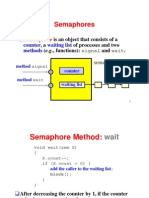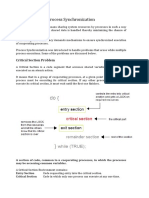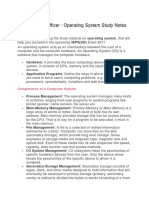0% found this document useful (0 votes)
239 views48 pagesProcess Synchronization Guide
This chapter discusses process synchronization and mechanisms for coordinating access to shared resources among concurrent processes. It covers the producer-consumer problem, Peterson's solution to the critical section problem, and synchronization techniques like mutex locks, semaphores, and monitors that can be used to ensure orderly access to shared resources.
Uploaded by
Crime HubCopyright
© © All Rights Reserved
We take content rights seriously. If you suspect this is your content, claim it here.
Available Formats
Download as PDF, TXT or read online on Scribd
0% found this document useful (0 votes)
239 views48 pagesProcess Synchronization Guide
This chapter discusses process synchronization and mechanisms for coordinating access to shared resources among concurrent processes. It covers the producer-consumer problem, Peterson's solution to the critical section problem, and synchronization techniques like mutex locks, semaphores, and monitors that can be used to ensure orderly access to shared resources.
Uploaded by
Crime HubCopyright
© © All Rights Reserved
We take content rights seriously. If you suspect this is your content, claim it here.
Available Formats
Download as PDF, TXT or read online on Scribd
/ 48
























































































